Exercises (3162)
rope catching
Stimulate circulation
Group work
All participants stuff a rope down the back of their trousers so that half of the halved rope hangs out visibly. Each participant then tries to grab as many ropes as possible. Even those who have no more rope continue to take part in the game. A playing field limit that may not be exceeded can be set if necessary. The winner is the player who has grabbed the most ropes at the end.
Variant:
Whoever loses their rope is eliminated and performs an additional exercise at the edge of the playing field (e.g. forearm support or wall sitting). From time to time, the playing field is reduced in size (as the number of participants decreases). Who can hold on to their rope until the end?
Per participant:
1 skipping rope
4 marking cones/caps ►Field boundary (optional)
Rope swinging
Stimulate circulation
Group work
Group of 3
Two participants swing the rope (2-3 skipping ropes knotted together). One participant goes to the centre from one side, jumps over the rope a few times and runs out on the other side. The jumper runs behind the swinger and returns to the centre. The jumper thus moves in the shape of an eight. Once the participant has completed a few rounds, the positions are swapped.
Attention:
Depending on the direction of the swing, there is an easier and more difficult side to get to the centre.
Variant I:
In the centre, try to pick up an object (e.g. a hat or a coin) and put it down again.
Variant II:
Start in the centre, starting position sitting or in the push-up position. In these positions, try to jump over the rope as it swings past.
Per group:
2-3 skipping ropes or 1 rope/rope
1 marking cone ►Variant
Skipping rope
Increase pulse
Group work
4-6 participants per group
At the start, a dice is rolled to determine how many jumps must be performed with the skipping rope at the reversal point (e.g. number of dice x 5 = number of jumps). After rolling the dice, the runner runs to the reversal point and performs the number of jumps determined by the dice before being allowed to return to the group to hand over to the next runner, who in turn defines the number of jumps with the dice.
Per group:
1 skipping rope
1 dice
2 colouring sticks
Skipping rope
Increase pulse
Individual work
At a signal from the instructor, the participants switch from leisurely rope jumping to very fast rope jumping on the spot until the instructor gives another signal. The exercise is repeated a few times to increase the heart rate several times.
Variant:
Pull the knees up to the navel while jumping rope (skipping) or supplement the rope jumping with other short intensive exercises (e.g. integrate a push-up and a stretch jump on a signal).
Participant:
1 skipping rope
Skipping rope
Light-Contact
Partner work
Skipping in place, alternating between bringing one leg to the ground and lifting the other leg up to navel height with the knee (skipping).
2 skipping ropes (one rope per participant)
Skipping rope
Stimulate circulation
Individual work
Stand upright on the balls of your feet with your feet shoulder-width apart, holding a skipping rope in your hands. Continuous hopping in place and simultaneous swinging of the rope (under the feet and overhead). Make sure that the heels are not completely off the ground (jumping on the balls of the feet/tips of the toes). The upper body should always remain upright while jumping (keep the torso tensed).
Jumping rope with low intensity (slow swinging, also incorporate breaks) is suitable for stimulating the circulation. By integrating different jumping forms, jumping can be made more varied through variation (e.g. double jumps, crossing arms, alternating left/right heel taps on the floor, straddle jumps, jumping in step position, alternating jumps, etc.). Pulling the tips of your feet towards your knees with each jump (bending your feet) is another way to vary your jumping.
1 skipping rope
Skipping rope
Increase pulse
Individual work
Stand upright on the balls of your feet with your feet shoulder-width apart, holding a skipping rope in your hands. Continuous hopping in place and simultaneous swinging of the rope (under the feet and overhead). Make sure that the heels are not completely off the ground (jumping on the balls of the feet/tips of the toes). The upper body should always remain upright during jumping (keep the torso tensed).
Jumping rope at high intensity (fast swinging) is a good way to get the heart rate up at the end of the warm-up (e.g. 8 x 20-second workload and 10-second break phase or 3 x 30-second workload with 1-minute break). The two-legged hopping can also be converted into a race on the spot (skipping) to further increase the intensity.
1 skipping rope
Rope skipping / ball kicking
Light-Contact
Partner work
The two positions are changed at each round.
Position 1:
Skipping rope by jumping on the spot with both legs.
Position 2:
Holding a medicine ball with both hands in front of the chest in a stepping position (staggered stance). Push the ball to the ground with one arm (side can be varied) and catch it again with both hands. After each kick, shift position slightly without crossing your legs and then kick the ball towards the floor again.
1 skipping rope
1 medicine ball
Ropeway tunnel
Increase pulse
Group work
Several groups of two line up in one or two rows (outward and return journey) and form one or two tunnels, so to speak. A distance of approx. 5 metres is maintained between the pairs. The rest of the participants line up in a column in front of the first group of two. The jumpers choose a swing direction and a rhythm together and then try to cross the tunnel. One swing direction is much easier. The aim is for the entire group to pass through the tunnel with/without intermediate jumps and, above all, without any interruptions/errors between the jumpers. The positions of the swimmers and runners are changed from time to time.
Per group of 2:
2-3 skipping ropes or 1 rope/rope
Rope pulling
Fighting and roughhousing games
Partner work

Two participants stretch a rope between them (holding the rope in their hands) and stand facing each other at a distance of approx. 3-4 metres. The participants try to pull their opponent over the centre line (or the opponent/the centre of the rope over a certain line). Whoever is pulled over the line first loses.
1 rope
2 marking cones/caps (optional) ►Field marking
Post set-up:
Mark the defined baseline (for the centre of the rope) using cones.
Lateral forearm support (left) ► lateral pillar bridge / side plank / side bridge
Power
Individual work
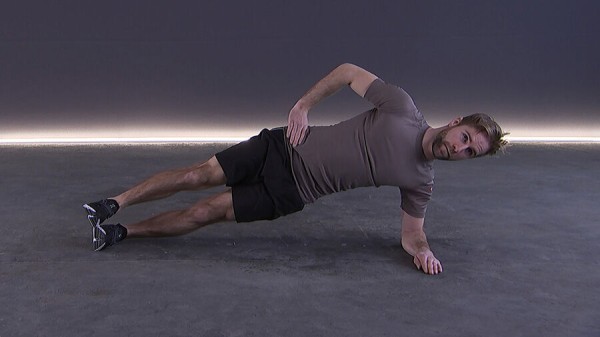
Lateral support on the (left) forearm (possibly on a wall for the correct straight position), free (right) arm supported on the hip or held upright, hold the position.
Attention:
Head, torso, hips and knees form a line (pelvis does not tilt backwards or forwards), keep the shoulder above the elbow.
Lighten:
Knees on the floor.
Harden:
Additional weight (on the hips); unstable support (possible for both the arm and the legs).
1 weight vest/weight disc/sandbag ► make the exercise more difficult (additional weight)
1 ball/1-2 balance cushions/1 balance board ► make the exercise more difficult (unstable surface)
Lateral forearm support (left) ► lateral pillar bridge / side plank / side bridge
Power
Individual work

Side support with the left forearm on the balance board. Raise your upper leg slightly off the floor (in extension of your body) and bend your lower leg on the floor (kneeling, foot pointing backwards). Hold the position you have assumed.
Attention:
Head, torso, hips and knees practically form a line (pelvis does not tilt backwards or forwards), keep shoulder above elbow.
Lighten:
Lateral forearm support without balance board; support upper leg extended on the floor as an extension of the body.
Harden:
Both legs stretched out in extension of the body (outer instep of the lower foot supports the overlapping legs).
Variant:
Lift and lower the pelvis.
1 balance board incl. roller
Lateral forearm support (right) ► lateral pillar bridge / side plank / side bridge
Power
Individual work

Side support on the (right) forearm (possibly on a wall for the correct straight position), free (left) arm supported on the hip or held upright, hold the position.
Attention:
Head, torso, hips and knees form a line (pelvis does not tilt backwards or forwards), keep the shoulder above the elbow.
Lighten:
Knees on the floor.
Harden:
Additional weight (on the hips); unstable support (possible for both the arm and the legs).
1 weight vest/weight disc/sandbag ► make the exercise more difficult (additional weight)
1 ball/1-2 balance cushions/1 balance board ► make the exercise more difficult (unstable surface)
Lateral forearm support (right) ► lateral pillar bridge / side plank / side bridge
Power
Individual work
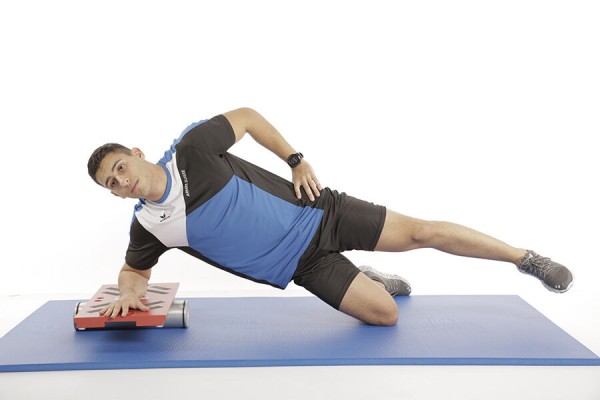
Side support with the right forearm on the balance board. Lift the top leg slightly off the floor (in extension of the body) and bend the bottom leg on the floor (kneeling, foot pointing backwards). Hold the position you have assumed.
Attention:
Head, torso, hips and knees practically form a line (pelvis does not tilt backwards or forwards), keep shoulder above elbow.
Lighten:
Lateral forearm support without balance board; support upper leg extended on the floor as an extension of the body.
Harden:
Both legs stretched out in extension of the body (outer instep of the lower foot supports the overlapping legs).
Variant:
Lift and lower the pelvis.
1 balance board incl. roller
Lateral forearm support / lateral support (left) ► side plank / lateral pillar bridge / side bridge
Power
Individual work



Progression I:
Side support on the left forearm with the legs in the foot supports (crossed over, top leg in front). Support the upper right arm on the floor in front of the body, lift the pelvis off the floor and hold the position. To increase the intensity, support the free arm on the hip or extend it vertically upwards.
Progression II:
Analogue to Progression I, but only supported on one hand. Increase the intensity according to progression I.
Attention:
Keep body tension, do not let hips sag, back straight, forearm under shoulder (for both progressions).
Harden:
The further away the head is from the attachment point, the more challenging the exercise becomes.
Variant I:
Lift and lower the pelvis.
Variant II:
Alternately bring the upper arm under the body and extend it upwards, accompanying the movement with the head.
1 sling trainer
Lateral forearm support / lateral support (right) ► side plank / lateral pillar bridge / side bridge
Power
Individual work



Progression I:
Side support on the right forearm with the legs in the foot supports (crossed over, top leg in front). Support the upper left arm on the floor in front of the body, lift the pelvis off the floor and hold the position. To increase the intensity, support the free arm on the hip or extend it vertically upwards.
Progression II:
Analogue to Progression I, but only supported on one hand. Increase the intensity according to progression I.
Attention:
Keep body tension, do not let hips sag, back straight, forearm under shoulder (for both progressions).
Harden:
The further away the head is from the attachment point, the more challenging the exercise becomes.
Variant I:
Lift and lower the pelvis.
Variant II:
Alternately bring the upper arm under the body and extend it upwards, accompanying the movement with the head.
1 sling trainer
Lateral forearm support with raised leg (left) ► lateral pillar bridge / side plank / side bridge
Power
Individual work

Side support on the left forearm (possibly on a wall for the correct straight position). Raise the top leg, extend the free arm in a high position (starfish) or support it on the hip and hold the position.
Attention:
Head, torso, hips and knees form a line (pelvis does not tilt backwards or forwards), keep the shoulder above the elbow.
Lighten:
Knee on the floor; spread the upper leg less.
Harden:
Additional weight (on the hip, on the upper leg for additional training of the leg muscles); unstable base (possible for both supporting arm and supporting leg).
1 weight cuff/weight vest/weight disc/dumbbell/sandbag ► make the exercise more difficult (additional weight)
1 ball/1-2 balance cushions/1 balance board ► make the exercise more difficult (unstable surface)
Lateral forearm support with raised leg (right) ► lateral pillar bridge / side plank / side bridge
Power
Individual work

Side support on the right forearm (possibly on a wall for the correct straight position). Raise the top leg and stretch the free arm upwards (starfish) or support it on the hip and hold the position.
Attention:
Head, torso, hips and knees form a line (pelvis does not tilt backwards or forwards), keep the shoulder above the elbow.
Lighten:
Knee on the floor; spread the upper leg less.
Harden:
Additional weight (on the hip, on the upper leg for additional training of the leg muscles); unstable base (possible for both supporting arm and supporting leg).
1 weight cuff/weight vest/weight disc/dumbbell/sandbag ► make the exercise more difficult (additional weight)
1 ball/1-2 balance cushions/1 balance board ► make the exercise more difficult (unstable surface)
Alternating lateral tilting of the upper body while standing
Power
Individual work

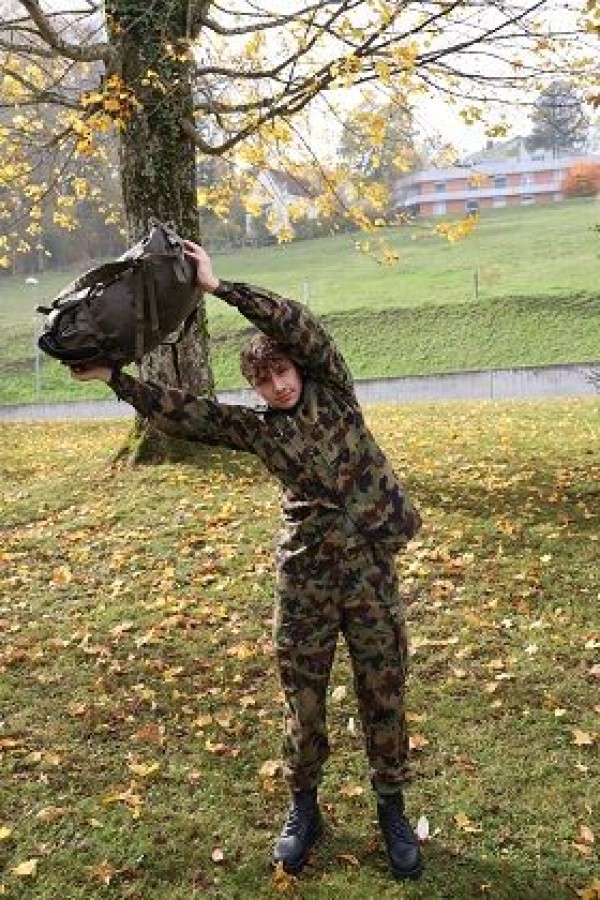
Stand upright with your hips wide apart, hold the object high above your head and then tilt your upper body alternately to the left and right side.
Attention:
Do not lean your upper body forwards or backwards, no hollow back (tense your torso).
Lighten:
No additional weight; lean your upper body less to the side.
Harden:
Additional weight (e.g. place stones in the helmet or a combat backpack)
1 helmet/(medicine) ball
1 combat rucksack/tyre (PUCH)/3-4 stones ► Make the exercise more difficult (additional weight)
Alternating lateral tilting of the upper body while standing ► side bend
Power
Individual work


Stand upright, shoulder-width apart with your feet in the loops. The gymnastics pole is held on the shoulders behind the head and the upper body is tilted alternately to the left and right side.
Attention:
Do not lean your upper body forwards or backwards, no hollow back (tense torso).
Lighten:
Select less strong elastic bands; roll up the elastic bands less.
Harden:
Select stronger elastic bands; roll up the elastic bands more.
1 gymnastic bar with elasticated straps
Lateral tilting of the upper body in forearm support ► pillar bridge / plank rolls
Power
Individual work

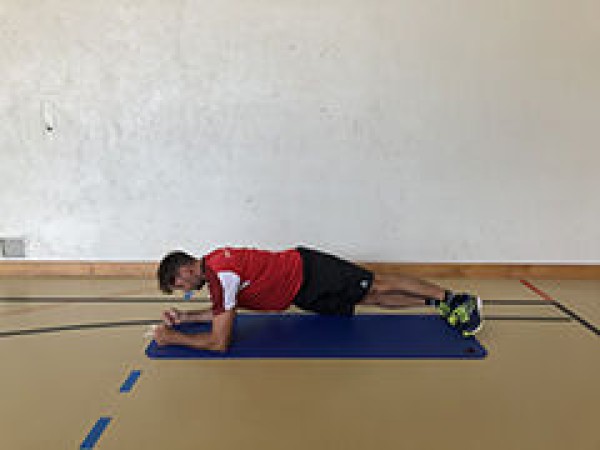

In the forearm support (the stretched legs and upper body practically form a line, the legs are supported on the tips of the toes and the upper body on the forearms, the forearms lie flat on the floor parallel to each other, the upper arms are vertical) tilt the upper body to the left or right side and return to the starting position.
Attention:
Head, torso, hips and knees practically form a line (do not stretch your buttocks upwards or allow them to sag, tense your stomach).
Lighten:
Knees on the floor.
Harden:
A stable base for the legs and/or arms is possible.
1-2 balls/balance cushions/balance boards ► Make the exercise more difficult (unstable surface)
Lateral raising of the arms in prone position ► prone T hold
Power
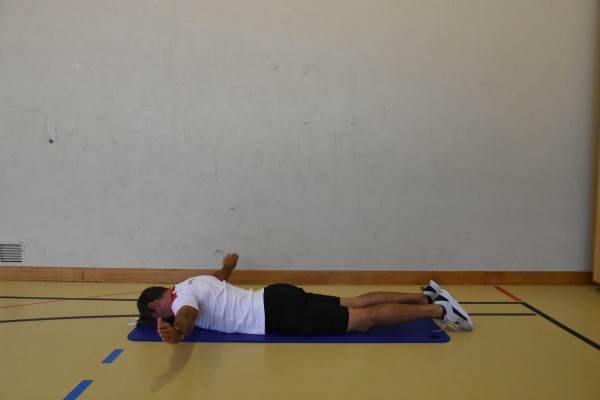
Lie on your stomach with your forehead resting on a folded sheet, feet shoulder-width apart, arms pointing to either side (T-position). From this position, pull the shoulder blades together and raise the arms until the elbows are at shoulder height and the arms are parallel to the floor (palms facing forward or downward). Keep your arms straight and hold the position.
Attention:
Only the arms should be raised, nothing else - aim to isolate the upper back.
Harden:
Hold additional weight in your hands or on your arms.
2 weight cuffs/2 weight balls/dumbbells ► Make the exercise more difficult (additional weight)
Lateral raising of the arms in prone position ► prone T raise hold / prone lateral raise hold
Power
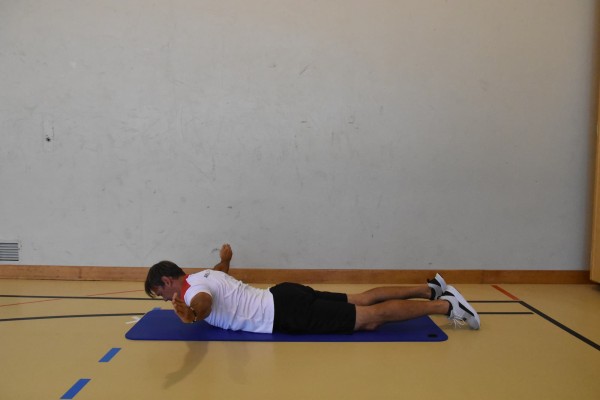
Lie on your stomach with your upper body slightly raised, feet shoulder-width apart, arms pointing to either side (T-position). From this position, pull your shoulder blades together and raise your arms until your elbows are at shoulder height and your arms are parallel to the floor (palms facing forward or downward). Keep your arms straight and hold the position.
Attention:
Only the arms should be raised, nothing else - aim to isolate the upper back.
Harden:
Hold additional weight in your hands or on your arms.
2 weight cuffs/2 weight balls/dumbbells ► Make the exercise more difficult (additional weight)
Lateral raising of the arms in prone position ► prone W hold
Power
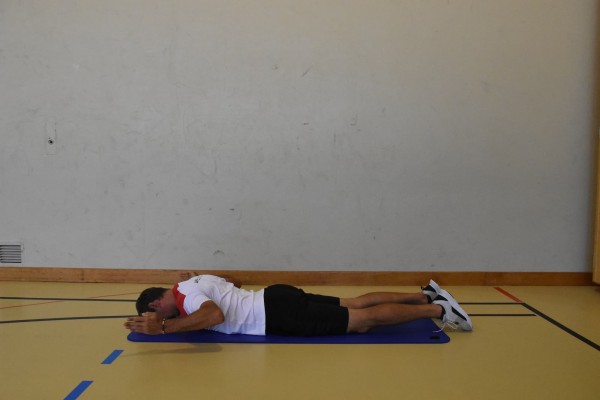
Lie on your stomach with your forehead resting on a folded sheet, feet shoulder-width apart, arms bent, elbows close to your body, arms pointing diagonally forwards to the respective side (W position). From this position, pull the shoulder blades together and raise the arms until the elbows are at shoulder height and the arms are parallel to the floor (palms facing inwards at an angle). Keep your arms straight and hold the position.
Attention:
Only the arms should be raised, nothing else - aim to isolate the upper back.
Harden:
Hold additional weight in your hands or on your arms.
2 weight cuffs/2 weight balls/dumbbells ► Make the exercise more difficult (additional weight)
Lateral raising of the arms in prone position ► prone raise hold
Power
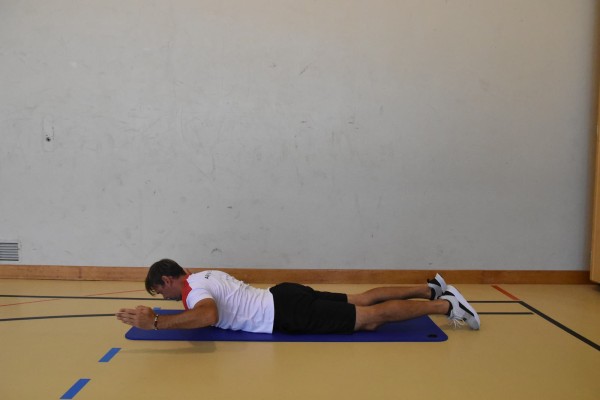
Lie on your stomach with your upper body slightly raised, feet shoulder-width apart, arms bent, elbows close to your body, arms pointing diagonally forwards to each side (W position). From this position, pull the shoulder blades together and raise the arms until the elbows are at shoulder height and the arms are parallel to the floor (palms facing inwards at an angle). Hold the position.
Attention:
Only the arms should be raised, nothing else - aim to isolate the upper back.
Harden:
Hold additional weight in your hands or on your arms.
2 weight cuffs/2 weight balls/dumbbells ► Make the exercise more difficult (additional weight)